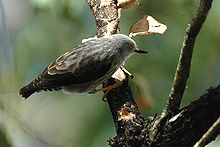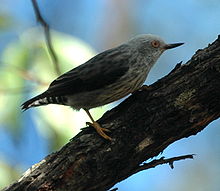- Sittella
-
Sittellas 
Varied Sittella, Daphoenositta chrysoptera Scientific classification Kingdom: Animalia Phylum: Chordata Class: Aves Order: Passeriformes Suborder: Passeri Family: Neosittidae
Ridgway, 1904Genus: Daphoenositta
De Vis, 1897Species - D. miranda
- D. chrysoptera

Global range (In red) The sittellas are a family, Neosittidae, of small passerine birds found only in Australasia. They resemble nuthatches, but whilst they were considered to be in that family for many years they are now afforded their own family. They do not migrate other than for local movements.
The sittellas are small woodland birds with thin pointed down-curved bills, which they use to extricate insects from bark. Nests are open cups in forked branches.
They were formerly classified in two separate genera with the Black Sittella in Daphoenositta and the Varied and Papuan Sittellas in Neositta. The two genera are now usually merged with Daphoenositta having priority.
Contents
Evolution and taxonomy
The true evolutionary affinities of the sittellas have long been clouded by their close resemblance to the Northern Hemisphere nuthatches.[1] As late as 1967 the sittellas were retained in that family by some authorities, although doubts about that placement had been voiced in the previous decades. Both their climbing technique and overall morphology are extremely similar; however they differ both in their sociality and their nesting behaviour, as sittellas create nests on branches whereas nuthatches nest in cavities in trees. In addition the specifics of the morphology of the leg differed, with sittellas having leg muscles more similar to those of the honeyeaters. Their placement was then moved to various families, including the Old World babblers (an infamous wastebin taxon), the true treecreepers (Certhiidae, which range across the Holarctic and Africa) and the Australian treecreepers (Climacteridae). Their relationship with the Australian radiation of passerines was suggested by S.A. Parker on the basis of egg colour, nest structure and nestling plumage, and their position in this radiation was vindicated by Sibley and Ahlquist's DNA-DNA hybridization studies.[2] These researchers placed the sittellas in a monotypic tribe within the superfamily Corvidae. Today they are afforded their own family in a clade close to the berrypeckers and longbills (Melanocharitidae) and the whistlers (Pachycephalidae).[1]
The sittellas comprise a single genus, Daphoenositta, which contains two species. The two species were once considered to be two genera, but when the two were lumped the genus name of the less well known Black Sittella was adopted (due to priority), while the family retained the family name based on the junior synonym (Neositta). The most common species, the Varied Sittella, was once thought to represent several separate species, including five species in Australia, but in spite of considerable variation in plumage there are extensive zones of hybridization where the forms overlap (including an area of Queensland where all five Australian subspecies exist),[3] and are now thought to be a single species with eleven subspecies. The Black Sittella has three recognized subspecies.
Morphology
The two species of sittella are small passerines which resemble nuthatches in appearance.[1] The wings are long and broad, and when spread have clearly fingered tips. The family has a generally weak flight, which may explain their inability to colonize suitable habitat on islands like Tasmania. The legs are short but they have long toes, but in spite of their lifestyle they show little adaptation towards climbing. They have short tails and are between 10-14 cm in length and 8-20 g in weight, with the Black Sittella tending to be slightly larger and heavier. The bill is dagger shaped in the case of the Black Sittella and slightly upturned in the Varied Sittella. The plumage of the Black Sittella is mostly black with a red face; that of the Varied Sittella is more complex, with the numerous subspecies having many variations on the theme. The sexes of some subspecies have entirely black heads, other white, and others dark crowns and paler throats. The backs of most subspecies are grey with darker wings, and the undersides are generally streaked or white. All sittellas exhibit some sexual dimorphism in plumage.
Vocalizations
The calls of sittellas are generally simple and uncomplicated. Apparently the family has no need for long distance territorial calls, and the majority of calls are simple contact calls utilized to retain flock cohesion.[1] The most commonly heard call is the chip contact call, although there also exists a rallying call (to call together the group), as well as begging calls issued by incubating females.
Habitat and behaviour
The sittellas are social and generally restless birds of scrub, forests and woodlands. In Australia they generally avoid only the dense rainforest, whereas in New Guinea this is the only habitat they inhabit, avoiding only lowland forest. They generally live at low densities, between 0.1 to 0.6 birds per hectare, and are sedentary. The sittellas are generally highly social, usually being found in groups of five or more individuals and only more rarely in pairs. Studies of Varied Sittellas in New South Wales suggest that they live in clans of eight to twelve individuals and defend mutual territories against other groups. Within the groups, mutual preening is common, and in the evening the groups roost communally as well. Birds traveling to the evening roosts do so at slightly different times, timing their arrival at 30-60 second intervals, presumably so as not to attract the attention of potential predators. Roost sites are usually high in trees on slightly inclined dead branches. All the birds in the group roost next to each other, touching, and facing the same direction.[4] Amongst Australian birds Varied Sittellas are usually the first to arrive at roost sites in the evening and the last to leave in the morning, although they are not necessarily the first to sleep or last to wake. At the roost site the position occupied along the branch is generally not random; instead males generally adopt positions at the edges of the group whilst young birds tend to be found in the centre.
Diet and foraging
The principal component of the diet of sittellas are insects and other arthropods.[1] In one study in new South Wales adult beetles were the most common component of the Varied Sittella's diet, around 36%; particularly favoured were weevils, ladybirds, leaf beetles Chrysomelidae) and click beetles (Elateridae). A further quarter of the diet was composed of spiders and true bugs. Also taken were beetle and moth larvae, grasshoppers, termites, wasps and bees. Ants were taken relatively infrequently compared to other Australasian birds in similar niches. The proportion of any one item in the diet apparently varies geographically and seasonally, for example another study found that beetle larvae composed 87% of the diet. The diet of the Black Sittella has, like other aspects of its biology, been little studied, although the stomach contents of one that were examined contained caterpillars and spiders.
Sittellas forage on horizontal branches and the trunks of trees. Their foraging techniques has been described as hopping rapidly along the length of a horizontal branch, pausing briefly to peer for prey, occasionally hanging underneath the branch but usually on top of it. Most of the time is spent on branches rather than on the trunks. Birds on the trunks may travel upwards or downwards. Within the forest sittellas usually forage in the canopy. There are sexual differences in foraging, with males and females choosing to forage in slightly different microhabitats within the tree.[1] Prey items are usually gleaned directly from the bark, although in a few instances sittellas will sally from the branch in order to snatch aerial prey. Having obtained prey sittellas will use their feet to hold it while they eat it, in a similar manner to parrots, and will also use their feet in order to hold back strips of bark in order to pry underneath it. There have even been isolated reports of tool use in some populations of sittellas.[5] Sticks were used to pry boring beetle larvae out of cavities, in a similar fashion to that of tool using Woodpecker Finches of the Galapagos.
Breeding
Very little is known about the breeding of either of the two species of sittella in New Guinea, although Black Sittellas in breeding condition have been observed August and May,[6] suggesting that they may either be biannual breeders or year round breeders. The Varied Sittella populations in Australia are cooperative breeders (and the group composition of Black Sittellas suggest they are too),[7] and possibly have to be in order to be successful. There is some evidence that not only to groups cooperate in raising the young, not an uncommon strategy in birds, but have a plural breeding system, where more than one pair inside the group nest, and the group help raise both broods. There have even been instances of two females sharing a nest.
95% of the nests found in a study in New South Wales were in stringybarks, particularly the species Eucalyptus macrorhycha. The nests were almost always located high in the tree. Nest construction took around 7 days, but lining and decorating the nest added a few days to this. Nest building duties were shared amongst the group, and the speed of construction depended on how many birds were involved. Nests are usually placed in the prong of two branches, and is a deep cup decorated in the bark of the tree it is built in, thereby camouflaging it. Around 2-3 eggs are laid and incubated by the breeding female (or females if two are sharing the nest) for 19-20 days.[7] Whilst incubating the breeding female is fed by the breeding male and helpers. After hatching the female broods the young for a few days, and for up to two weeks at night. The chicks are fed for 19-20 days in the nest. After fledging the chicks have a protracted period of parental care lasting up to 80 days, although 60 days is more usual.
Species
- Black Sittella, Daphoenositta miranda
- Varied Sittella, Daphoenositta chrysoptera
- Papuan Sittella, Daphoenositta (chrysoptera) papuensis
References
- ^ a b c d e f Noske, R. (2007) "Family Neosittidae (Sittellas)" P.p. 628-639 in Del Hoyo, J.; Elliot, A. & Christie D. (editors). (2007). Handbook of the Birds of the World. Volume 12: Picathartes to Tits and Chickadees. Lynx Edicions. ISBN 978-84-96553-42-2
- ^ Sibley C & J Ahlquist (1982) "The Relationships of the Australo-Papuan Sittellas Daphoenositta as indicated by DNA-DNA hybridization". Emu 82 (3): 173 - 176 doi:10.1071/MU9820173
- ^ Ford, J (1980) "Hybridization between contiguous subspecies of the Varied Sittella in Queensland". Emu 80 (1): 1-12 doi:10.1071/MU9800001
- ^ Noske, R. (1985) " Huddle-roosting behaviour of the Varied Sittella Daphoenositta chrysoptera in relation to social status". Emu 85 (3): 188 - 194 doi:10.1071/MU9850188
- ^ Green, C. (1972) "Use of tools by Orange-winged Sittella". Emu 72 (4): 185-186
- ^ Rand, A.L. (1936) "The Rediscovery of the Nuthatch Daphoenositta with Notes on Its Affinities". Auk 53 (3): 306-310
- ^ a b Noske, R (1998) "Social Organisation and Nesting Biology of the Cooperatively-breeding Varied Sittella Daphoenositta chrysoptera in North-eastern New South Wales." Emu 98: 85-96 doi:10.1071/MU98009
External links
- Sittella videos on the Internet Bird Collection
Categories:- Daphoenositta
- Neosittidae
- Genera of birds
Wikimedia Foundation. 2010.

